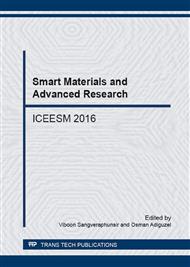[1]
Wright PK. Mater Sci Eng 1998; A245: 191-200.
Google Scholar
[2]
Peichl A, Beck T, Vo¨hringer O. Surf Coat Technol 2003; 162: 113-8.
Google Scholar
[3]
Baufeld B, Tzimas E, Mu¨ llejans H, Peteves SD, Bressers J, Stamm W. Mater Sci Eng A 2001; 315: 231-9.
Google Scholar
[4]
Bartsch M, Baufeld B, Dalkilic¸ S, Mircea I. Mater Sci Forum 2005; 492-493: 3-8.
Google Scholar
[5]
Utpal Borah, Diptimayee Samantaray, Shaju K. Albert, A. K. Bhaduri, T. Jayakumar, Thermo Mechanical Axial-Torsion Testing to Assess Workability Modelling Using Finite Element Method and Experimental Validation, International Journal of Metallurgical Engineering, vol. 2, pp.214-220, (2013).
Google Scholar
[6]
H. Sehitoglu. Thermal and Thermomechanical Fatigue of Structural Alloys. In ASM Handbook: Fatigue and Fracture, volume 19, pages 541-556. ASM International, (1996).
DOI: 10.31399/asm.hb.v19.a0002391
Google Scholar
[7]
J. Lemaitre. A course in damage mechanics. Springer, Berlin, (1996).
Google Scholar
[8]
T. Dahlberg. Material fatigue. Number LiTH-IKP-S-459. Solid Mechanics, IKP, Linkoping University, Sweden, (1997).
Google Scholar
[9]
R. Kowalewski and H. Mughrabi. Thermo-mechanical and isothermal fatigue of a coated columnar-grained durectionally solidified nickel-base superalloy. In Sehitoglu H. and Maier H. J., editors, Thermo-mechanical Fatigue Behavior of Materials, volume 3 of STP 1371, pages 3-17, West Conshohocken PA, March 2000. ASTM. ASTM special technical publication.
DOI: 10.1520/stp15250s
Google Scholar
[10]
Zineb A, Abdellatif K, Cabrera F M 2010. American J. of Engineering and applied Sciences. 3 740-8.
Google Scholar
[11]
L.L. Mishnaevsky Jr and S. Schmauder, A model of damage and fracture based on fuzzy sets theory ECF 11- Mechanisms and mechanics of damage and failure. MPA, University Stuttgart, Germany.
Google Scholar
[12]
B. Peeters, G. DeRoeck. One-year Monitoring of the Z24-Bridge: Environmental Effects versus Damage Events. Earthquake Engineering and Structural Dynamics, Vol. 30 (2001), pp.149-171.
DOI: 10.1002/1096-9845(200102)30:2<149::aid-eqe1>3.0.co;2-z
Google Scholar
[13]
C.R. Farrar, S.W. Doebling, P.J. Cornwell, E.G. Straser. Variability of Modal Parameters Measured on the Alamosa Canyon Bridge. Proceedings of 15th International Modal Analysis Conference, Orlando, USA, 1997, pp.257-263.
Google Scholar
[14]
M. Ralbovsky, S. Deix, R. Flesch. Frequency Changes in Frequency-based Damage Identification. Structure and Infrastructure Engineering, Vol. 6 (2010), pp.611-619.
DOI: 10.1080/15732470903068854
Google Scholar
[15]
G. DeRoeck, B. Peeters, J. Maeck. Dynamic Monitoring of Civil Engineering Structures. Computational Methods for Shell and Spatial Structures, IASS-IACM, Athen, Greece, (2000).
Google Scholar
[16]
W.H. Hu, C. Moutinho, E. Caetano, F. Magalhães, Á. Cunha. Continuous Dynamic Monitoring of a Lively Footbridge for Serviceability Assessment and Damage Detection. Mechanical Systems and Signal Processing, Vol. 33 (2012), pp.38-55.
DOI: 10.1016/j.ymssp.2012.05.012
Google Scholar


